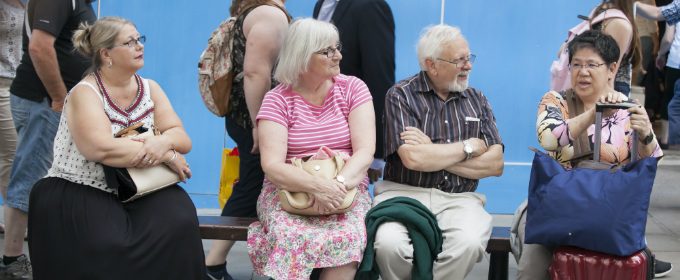Sophie Yarker is a Research Fellow at the Manchester Institute for Collaborative Research on Ageing (MICRA), working on the Greater Manchester-based Ambition for Ageing programme. In this blog, she discusses her research into the importance of social infrastructure for older people and the need to think about it in new ways.
- Face-to-face interactions are the building blocks of all public life and for older people in particular they are vital for building the social networks that help protect against social isolation.
- A diversity of social infrastructure helps older people to have these face-to-face interactions and develop different types of relationships.
- Policymakers, businesses and communities need to start thinking differently about social infrastructure and widen thinking on what spaces in our neighbourhoods can contribute sociality.
Social infrastructure often goes unnoticed, yet it has a critical role in our neighbourhoods by providing somewhere for social interaction to take place. Community centres, libraries, GP surgeries, religious organisations, parks and squares, and commercial establishments such as shops, cafes and post offices, provide us with spaces where we can meet with others, even if sociality is not their main remit. Face-to-face interactions are described by sociologist Eric Klinenberg as the building blocks of all public life and for older people in particular they are vital for building the social networks that help protect against social isolation.
As part of my research, I have written a report for the Ambition for Ageing programme. In the report I review the academic literature on the role of social infrastructure and reflect on key learnings from the project.
Different types of social relationships
I argue that a diversity of social infrastructure is important as it helps support different types of relationships. Members’ clubs and associations, for example, tend to draw together people of similar interests or background which can be highly beneficial for the building of what sociologists term bonding capital, that which connects people through some sense of commonality. On the other hand, social infrastructure that is used by a diversity of people, such as parks and retail spaces, lend themselves to supporting bridging capital, this referring to social connections made between people who are outside each other’s ‘usual circles’. For older people, the ability to build even weak social ties with different groups not only helps maintain connections as we age, but also provides bridges into social worlds we were previously unfamiliar with. This can allow us to expand our access to social support networks and increase personal resilience in times of crisis or change.
Spaces that allow social contact
Klinenberg argues that public libraries are one of the most critical yet under-valued forms of our social infrastructure. They offer spaces of culture and companionship to all ages but can be particularly important for older people. There is no financial barrier, so patrons are able to stay and use the facilities as long as they wish and their community-orientated service works to remove any stigma that some might associate with some activities geared specifically towards older people. By using the library services, attending programmed events or, as increasingly seen in the UK, volunteering at the library, older people are presented with multiple opportunities for social contact with those perhaps from social groups they would not normally socialise with. Therefore, there is considerable potential for public libraries to support the building of bridging capital for older people by providing an inclusive and neutral environment within neighbourhoods.
However, due to local authority spending cuts libraries are under increasing threat. Since 2010, 36 libraries have closed in Greater Manchester or had their services scaled back (data from GM Libraries), therefore removing a key asset in the neighbourhoods affected. While some library services have been transferred to other public organisations such as schools, others have been either wholly or partially taken over by the community and voluntary sector. The report stresses that despite the often informal and unintended nature of some our social infrastructure is not naturally occurring and therefore requires direct investment and support.
Thinking differently about social infrastructure
In the face of closures of vital community assets, community stakeholders need to start thinking more laterally about our social infrastructure and widen our thinking on what spaces in our neighbourhoods can contribute to the types of sociality discussed here. This means looking outside of the traditional community and voluntary sector and recognising the value of other spaces that can contribute to the development of social networks for older people.
Supporting local public libraries is one way we can do this, but so too is looking to some of the less obvious spaces in our neighbourhoods such as local shops, parks and other public spaces and thinking about how these might be better organised to support social interaction. Organising such spaces so that they facilitate talking and that people do not feel rushed is key to this as even low-level interactions such as passing the time of day allows the development of familiarity between neighbours. This can include ensuring there is adequate seating in parks, or providing ‘chatty’ tables in cafes where people who are on their own are encouraged to share a table with each other for conversation. Public spaces that have a diversity of users visiting at different times of the day have been shown to contribute to the vibrancy of community life; therefore supporting different sections of the community to use parks and other greenspace can be beneficial. Community stakeholders should be encouraged to share resources such as local businesses opening up spaces for community group meetings for example.
As urban populations continue to age, and public services and community organisations continue to be stretched, it is more important than ever to think holistically and creatively about how we support the social and civic life of our neighbourhoods. To do this we need to have a better appreciation of the critical nature of our social infrastructure.
